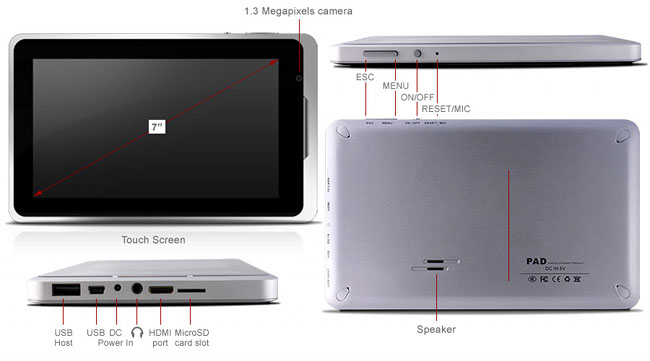O’reilly’s Android Open Conference 2011 will take place on 9-11 October 2011 in San Francisco. This is the first time this conference takes place. According to the organizers this conference will “cover the entire Android ecosystem. Whether you’re a developer, IT pro, business decision-maker, or marketer, you’ll find the latest and best information for maximizing the power of the Android platform”. There will be keynotes, practical workshops, and expert-led sessions dealing with: Building Android apps: best practices Android internals—under the hood Development tools New frameworks Alternative languages Gaming and game development Enterprise solutions and considerations Performance and security Analytics and revenue models Multiple Android markets Promotion and consumer needs and much more Please find below the schedule for the workshops (Sunday 9th October 2011) and conferences (10-11 October 2011) related to application development and platform development during the 3-day conference. Schedule on the 9th of October 2011 for Application Development […]
Linaro 11.08 Release with Linux Kernel 3.0.3
Linaro has just released version 11.08 based on Linux Kernel 3.0.3 with support or TI Beagleboard, BeagleBoard-xM & Pandaboard, ST Ericsson Snowball, Freescale i.MX53 development board and Samsung Origen board. Here are the highlights of the release: Android The Linaro 11.08 toolchain release of GCC 4.6 has compiled the Origen, BeagleBoard, BeagleBoard-xM, PandaBoard and Snowball builds, and are running Android 2.3.5 with a 3.0 Linux kernel. Together with the mainline kernel focused builds for BeagleBoard and PandaBoard and a preliminary i.MX53 build, the Android Platform Team ships 6 builds this month. A first! Android Platform code aliasing violations have been fixed allowing the use of strict-aliasing for better optimizations with gcc 4.6 based toolchains. The Android toolchain 11.08 has been released and has received numerous updates, including updated binutils and current gmp/mpfr/mpc. Benchmarks are available here. libjpeg-turbo 1.1.1 and ffmpeg with support for H.264 and WebM build are available on […]
X10 AirPad: 200 USD Android 2.3 Tablet powered by Rockchip RK2918
X10 has started to sell its own android tablet for 199.99 USD. The X10 AirPad is powered by Rockchip RK2918, a 1.2GHz, Cortex-A8-based processor, 512 MB RAM and 4GB of flash storage, and runs Android 2.3 (gingerbread). It features a seven-inch, 800 x 480 pixel capacitive display, a 2 MP camera and an HMDI output supporting 1080p. Its specifications are similar to Arnova 7 G2 also powered by RK 2918 @ 1 Ghz, the second version of Arnova 7 that runs Android 2.3 and features a 7″ capacitive display and is said to be sold in Hong Kong for around 215 USD. Here are the X10 AirPad 7″ Android Tablet Specifications: CPU: 1.2 Ghz Rockchip 2918 Cortex A8 processor + 600 Mhz DSP Display: 7″ 800×480 resolution TFT LCD screen Touch-screen: Capacitive multi-touch, 5 point touch OS: Android 2.3, with Flash 10.1 Camera: 2 Megapixel camera with video recording and […]
200 Android Development Video Tutorials
If you’ve ever wanted to learn how to develop applications for Android but reading books bores you, you now have the chance to teach yourself Android software development with 200 video tutorials (about 20 hours). The videos have been uploaded to ChangingTheUnknown Youtube channel and can be accessed via TheNewBoston – Android playlist. To give you an idea of what you’ll learn, here are the titles of the first 10 tutorials: Download and Install the Java JDK Installing Eclipse and Setting up the ADT Installing Android SDK and Set up Emulator Setting up an Android Project Overview of Project and Adding Folders Introduction to Layouts in XML Creating A Button in XML and Adding an ID Setting up Variables and Referencing XML ids Set up a Button with OnClickListener Using setText method for our button You can watch the first tutorial: “Android Application Development Tutorial – 1 – Download and […]
LinuxCon 2011 Presentation: Embedded Systems
The fourth presentation entitled “Embedded Systems” was presented by Tim Harder, developer at OSUOSL (Oregon State University Open Source Lab) on the 16th of August 2011 at LinuxCon 2011. Abstract: This presentation deals with software development for Embedded Systems especially focusing on Linux and open source. It describes current software development challenges such as fast software life cycle and memory footprint issues, lists several open hardware projects (Beagleboard, Pandaboard, Bug Labs, Gumstix), microcontrollers (Arduino and TI MSP430), different operating systems (Android, Meego) and toolchain build tools (Buildroot, Yocto) for embedded systems. It also explains specific challenges to embedded software development such a the numerous number of hardware platforms and software & hardware tools. Finally, it deals with the cross-compilers, emulators (e.g. qemu) and debugging tools (gdb, jtag, serial console, etc…). If you want to download the presentation slides, please go to Embedded Systems and use the download button on top of […]
ARM TechCon 2011: Software & System Design Schedule
ARM Technology Conference (TechCon) 2011 will be hosted in Santa Clara on the 25-27 October 2011. There will be many events and classes related to Chip Design and Software & System Design. The Software & System Design events will take place on the 26th and 27th October 2011. Here’s the schedule for Software & System Design events for the 26th of October: Time Class Track 11 am The 2012 Compute Subsystem Creating Smarter Systems 11 am Practical Cortex Debugging: Serial Wire Viewer and ETM Tracing Developing/Debugging 11 am Integrating a CMOS Imaging Sensor into an ARM-Based Embedded Application Human Interface Design 11 am Embedded IPv6 – Now is the time Networking & Connectivity 11 am RSA & AES Libraries protected against side-channel attacks Safety & Security 11 am Introduction to the ARM Architecture The Fundamentals of ARM 12 pm Optimizing SoC development through a common design foundation Creating Smarter Systems […]
HTC Releases OpenSense SDK
HTC recently released OpenSense SDK, a framework encompassing all available HTC SDKs as well as features that will be offered in the future for HTC Sense user interface. Supported features include: Common Controls API: UI widgets and components that will provide developers with the ability to provide the Sense UI look and feel to their applications. Stereoscopic 3D (S3D) API: API documentation and sample code that illustrates how to programmatically enable the 3D display mode of the parallel barrier based screen for various types of applications. This API is provided as part of the phone add-on extension to the Android SDK. Tablet Pen API: API documentation and sample code for providing a framework for fully fledged drawing and painting applications as well as full access to the pen events at a low level. This API is provided as part of the tablet add-on extension to the Android SDK. API documentation […]
Pandaboard Benchmark: Android (Pandroid) vs Linaro Android
Here’s a video with two Pandaboards (powered by TI OMAP 4) running Android. On the right, there’s Google’s Android, built with the gcc 4.4 toolchain provided by Google and the Pandroid kernel. On the left, there is a Linaro build, using Linaro’s gcc 4.5 toolchain and Linaro’s 3.0 kernel for the Panda board. There is a noticeable difference in the time taken by both boards to execute the demo. (Android Linaro being faster). The demo (Benchmark by 0xlab) uses software decode on both boards. They also showcase the Freescale i.MX53 and ST Ericsson Snowball development boards. Jean-Luc Aufranc (CNXSoft)Jean-Luc started CNX Software in 2010 as a part-time endeavor, before quitting his job as a software engineering manager, and starting to write daily news, and reviews full time later in 2011. www.cnx-software.com







